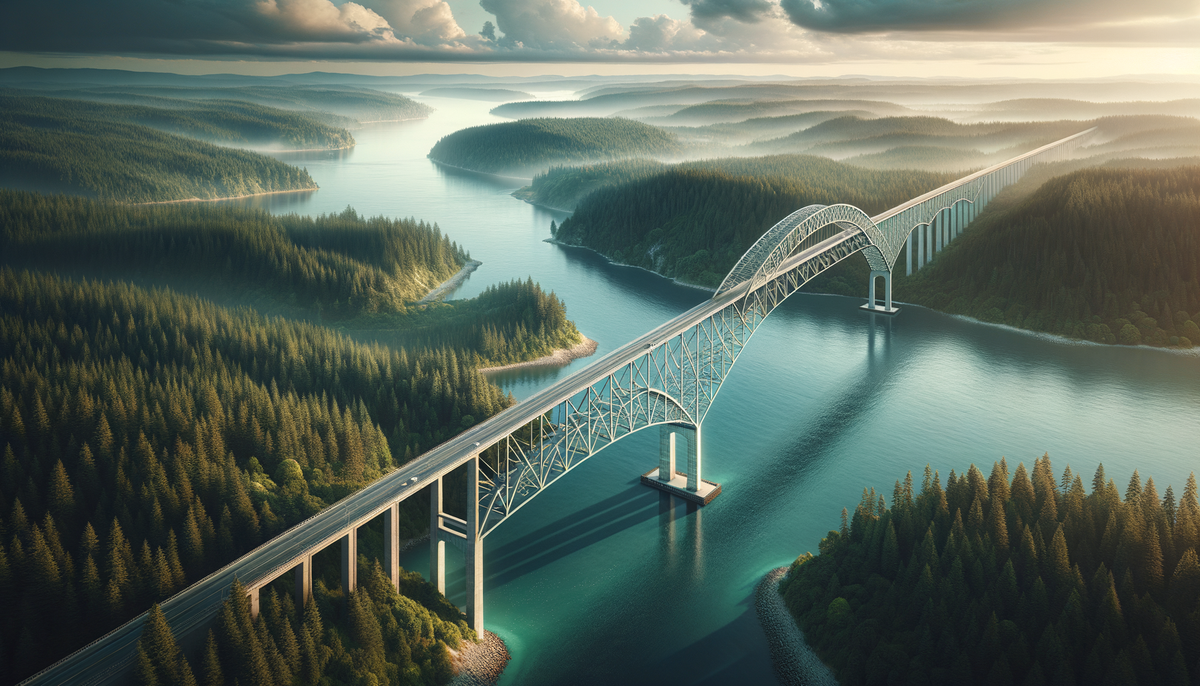Navigating the Waters: The Hood Canal Bridge and Its Role in Modern Infrastructure
Explore the innovative engineering and resilient design of the Hood Canal Bridge, a critical link in Washington’s infrastructure.

Navigating the Waters: The Hood Canal Bridge and Its Role in Modern Infrastructure
The Hood Canal Bridge stands as a testament to human ingenuity, bridging the Olympic and Kitsap Peninsulas in Western Washington. As the longest floating bridge in a saltwater tidal region, its design and construction have drawn significant attention from engineers and the public alike. This iconic structure not only supports crucial transport links but also showcases the sophisticated engineering that addresses unique environmental challenges.
The Construction and Evolution of the Hood Canal Bridge
Spanning over a mile across the Hood Canal fjord, the bridge’s construction was a remarkable feat given the natural obstacles, including high tides and fierce winds. Engineers, initially skeptical, developed new methodologies for utilizing floating pontoons as traditional support columns were impractical under the deep waters, sometimes reaching depths of up to 340 feet. These pontoons, initially fabricated in Seattle, faced early challenges, such as pontoon sinking and stormy seas during installation, necessitating revisions in their design and assembly (source, source).
The bridge is comprised of robust components, including hollow concrete pontoons anchored to the canal floor by substantial steel wiring. Its retractable section allows for marine traffic to navigate unimpeded, enhancing its utility in the busy Puget Sound region (source).
A Historical and Technical Marvel
Opened in 1961, the bridge was later renamed the William A. Bugge Hood Canal Bridge in honor of the state’s former Director of Highways. However, it was a major storm in 1979 that marked a pivotal moment in its history, when a portion of the bridge sank. The subsequent reconstruction from 1979 to 1982 saw significant enhancements, including increased anchor weight and number, improved roadways, and additional draw spans, emphasizing its resilience and adaptability.
The innovative design includes 29 concrete pontoons, which form the primary support structure, supplemented by two concrete and two Warren truss approach spans. This engineering allows the bridge to withstand sails through its retractable sections, maintaining its operational integrity despite the maritime environment (source).
Operations and Challenges: Keeping the Bridge Afloat
Managed by the Washington State Department of Transportation (WSDOT), the Hood Canal Bridge operates under careful surveillance, particularly given its vulnerability to environmental conditions like high tides and winds. These factors occasionally necessitate closures, during which WSDOT provides real-time updates to minimize traffic disruption (source).
The bridge’s strategic importance is underscored by its role in facilitating local commerce and tourism, cementing its status as an economic and logistical asset. Moreover, its technical design is continually scrutinized and improved, ensuring the bridge remains effectively serviceable amidst evolving environmental pressures (source).
Practical Insights for Industry Professionals
For professionals engaged in bridge engineering and infrastructure development, the Hood Canal Bridge provides several valuable insights:
- Adaptive Engineering: Successful infrastructure projects often require adaptive strategies that incorporate novel solutions like floating pontoons to overcome geographical and environmental challenges.
- Regular Maintenance and Monitoring: Given the bridge’s operational environment, frequent monitoring and maintenance are crucial in extending its service life and ensuring safety.
- Community and Ecological Considerations: Infrastructure should balance technical advancement with its impact on local communities and ecosystems.
Such insights reinforce the bridge’s role not only as a transportation link but also as an engineering landmark for those in the field to study and emulate.
Explore the Innovative Solutions: Call to Action
We invite industry leaders, engineers, and enthusiasts to delve deeper into the engineering marvels that make the Hood Canal Bridge possible. Explore further details and collaborate with our team of experts in infrastructure development to foster innovation and excellence in engineering projects.
Contact us today to learn more about our services and how we can support your next big infrastructure project!




